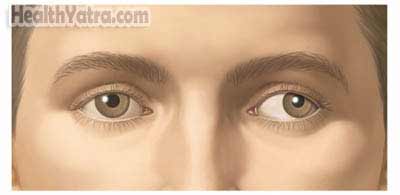Definition
Amblyopia is a condition that occurs when there is a reduction of vision in one eye. Amblyopia, which is often called “lazy eye,” is most common in infants and children, but it can also occur in adults. Amblyopia is not contagious.
There are two common types of amblyopia:
- Anisometropic amblyopia occurs when the vision in one eye differs from the other. This is often caused by a large difference in eyeglass prescription. The difference may be caused by one eye being more nearsighted or farsighted than the other or caused by large differences in astigmatism. In general, people who have anisometropic amblyopia are often asymptomatic (showing no signs of the condition).
- Strabismic amblyopia occurs when there is a visible misalignment (crossing) of one eye.

If you suspect that you or your child has this condition, contact the doctor. The sooner amblyopia is treated, the more favorable the outcome.
Causes
Amblyopia is caused when the brain prefers (favors) one eye to the other. The brain’s preference (liking) for one eye over the other can weaken and reduce vision in the eye that is less used.
There are no apparent genetic or environmental factors that can be attributed to causing amblyopia.
Risk Factors
A risk factor is something that increases your chance of getting a disease or condition.
The following factors increase your chances of developing amblyopia. If you have any of these risk factors, tell your doctor:
- Age: children nine years of age or younger with:
- Crossed eyes
- A large difference in eyeglass prescription between the two eyes (nearsighted, farsighted, or astigmatism)
- Visual blockage such as a cataract, droopy eyelid, or corneal scarring
Symptoms
The symptoms for amblyopia vary from person-to-person. Some people might be asymptomatic (showing no signs of the condition) while others are symptomatic (showing signs of the condition). If you experience any of these symptoms do not assume it is due to amblyopia. These symptoms may be caused by other, less serious health conditions. If you experience any one of them, see your physician.
- A droopy (the inability to fully-open) eyelid that blocks the pupil
- Headaches
- Blurry vision
- Excessive squinting or closing of the eyes
- Repeatedly closing of one eye in bright sunlight
- A misalignment (crossing) of one eye, generally the eye that is less used will excessively turn toward the nose
Diagnosis
Your doctor will ask about your symptoms and medical history, and perform a physical exam. You may also be referred to an ophthalmologist, a doctor who specializes in the medical and surgical treatment of eye disorders and vision measurement. Since amblyopia tends to occur in young children, the types of tests an ophthalmologist will perform will be determined by the patient’s age and their ability to respond to the ophthalmologist. Tests may include the following:
- Visual acuity assessment testing (VAT)—such as the Lea Symbols test that is used to assess distant vision.
- Cycloplegic refraction test—which is performed to determine how the eyeball displays and receives images produced by the lens of the eye. To perform the test, eye drops are used to dilate (widen the pupil) for a better view of the eye. To determine the direction of light the eye receives and displays, the dilating drops briefly paralyze (impair movement or make inactive) the eye muscles that control focusing.
- Retinoscopy which allows an eye specialist to determine a preverbal child’s eyeglass prescription
- Prisms to determine the amount of crossing between the two eyes if present
Treatment
Talk with your doctor about the best treatment plan for you. First, correction of any visual obstructions, such as cataracts, needs to be accomplished. In addition, the doctor will treat any significant visual abnormalities or defects, such as excessive nearsightedness, farsightedness, or astigmatism with glasses or contact lenses. Only then a child is encouraged to use the amblyopic eye.
Treatment options include the following:
Atropine Penalization
Atropine drops or ointment is placed in the non-amblyopic eye (the eye that is favored by the brain or the sound eye). This causes the sound eye to become unfocused and forces the patient to use the lazy eye.
Occlusive Therapy
One type of treatment includes placing a patch over the non-amblyopic eye (the sound eye), which forces the patient to use the lazy eye.
Bangerter foils are another option. The foils, which are made of thin vinyl, are placed over the eye glass lens, covering the non-amblyopic eye. Just like with the patch, this forces the weaker eye to become stronger because you will not be able to see well with the foiled lens.
Prevention
While there is no way to prevent amblyopia, vision screening can help to detect the condition at an early age. Children aged 3-5 should be screened. Often children less than 3 are also checked for eye problems. If your child does have amblyopia, he will have a better outcome if treatment is started right away.
Amblyopia Treatment in India – Page Keywords:
Amblyopia Definition, Amblyopia Definition Causes, Amblyopia Symptoms, Amblyopia Treatment in India, Amblyopia Treatment Cost in India, Amblyopia Surgery Cost, Top Amblyopia Treatment Hospital, Top Amblyopia Treatment Doctor in India, Amblyopia Meaning in Marathi, Amblyopia Treatment Near me, Amblyopia Complications, Travel India for Amblyopia Treatment, Amblyopia Treatment in Arab Countries, Amblyopia Treatment in Bangladesh, Amblyopia Treatment in Dhaka, Amblyopia Meaning in Bengali, Amblyopia Meaning in Arabic, Amblyopia Meaning in Hindi, Amblyopia Treatment in Bahrain, Amblyopia Treatment in Egypt, Amblyopia Treatment in Iraq, Amblyopia Treatment in Jordan, Amblyopia Treatment in Kuwait, Amblyopia Treatment in Lebanon, Amblyopia Treatment in Saudi Arabia, Amblyopia Treatment in United Arab Emirates, Amblyopia Treatment in Sudan, Amblyopia Treatment in Tunisia, Amblyopia Treatment in Nepal, Amblyopia Treatment cost,
Amblyopia Treatment Cost in India, Amblyopia Treatment Top Doctors Best Hospital in India
